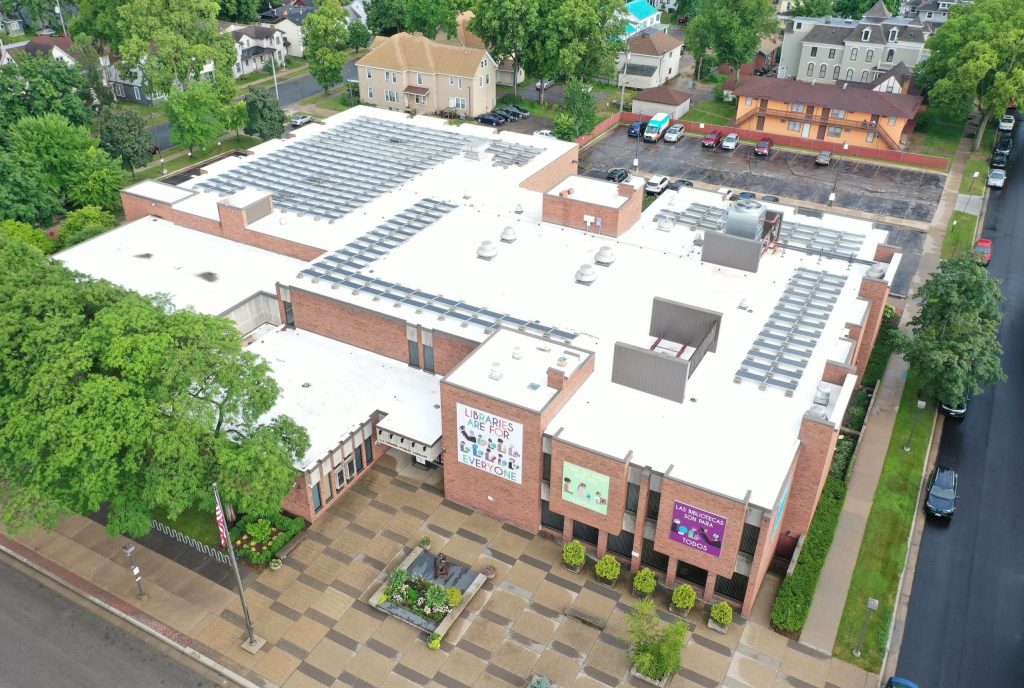La Crosse Finds Path to Solar Savings
Evades state law on third party ownership by signing energy savings contract with Johnson Controls.
A lack of clarity over third-party-owned solar in Wisconsin has stymied cities’ efforts to install photovoltaics on municipal buildings, but one city says it’s come up with a workaround that could be replicated elsewhere.
Wisconsin utilities have argued that state law prohibits companies from generating solar power on property they do not own. A common arrangement in most states, third-party ownership allows local governments, churches, nonprofits, and other untaxed entities to benefit from solar tax credits.
La Crosse essentially hired Johnson Controls to reduce the city’s energy costs over the next 20 years under what’s known as an energy performance savings contract. As part of a suite of energy efficiency measures, some of the savings come from solar installed on city-owned buildings.
Four 100-kilowatt arrays have already been installed on the public library, municipal service center, city hall and arena. Three more arrays on two fire stations and in a park are planned.
Johnson Controls official Jennifer Stentz described the arrangement as a “really elegant solution” for municipalities seeking to install solar despite the obstacles posed by the state’s lack of clarity around third-party ownership.
“Without having other means at their disposal like PPAs [power purchase agreements], this was really something that allowed them to accelerate” renewable investments, said Stentz, a vice president and general manager at Johnson Controls. “Their ability to take this on showed they wanted to be a role model.”
Performance contracts
La Crosse environmental planner Lewis Kuhlman said the city was mulling different sustainability investments in 2018 and “getting pitched by a bunch of companies trying to sell us different products for different departments — it was hard to wrap your head around.”
Ultimately the city put out a request for proposals and chose the bid from Johnson Controls to provide a comprehensive energy savings bundle including solar, replacing old boilers, LED lighting and more. The investments are guaranteed to provide a certain amount of energy savings, meaning there is little risk to La Crosse.
In all, the contract is meant to deliver $11 million worth of energy savings over 20 years, with the first phase launching in 2019 and an expansion announced last year. The City Council has approved the plans for each of the three phases of the project, and Stentz said a fourth phase is under discussion.
“A performance-based contract is a pretty common procurement method for many institutional and government customers, and each state has its own performance-based contracting legislation — some allow water conservation measures to be included, some allow renewables,” she noted. “The uniqueness is the city [of La Crosse] understanding that it’s at their disposal as a solution they can leverage” to get solar and other improvements.
Under a performance contract, the city does not need to tap its capital budget for energy-related investments. Johnson Controls essentially puts up the money for new infrastructure and upgrades, and pays itself back plus a profit through the energy savings La Crosse achieves. If the total energy savings are less than promised, Johnson Controls assumes that loss.
“They can ensure holding Johnson Controls accountable to achieve the objectives we set,” Stentz said. “It reduces the risk to the community, and they can get the return on investment they planned.”
Johnson Controls is also responsible for maintaining the solar panels and other investments made under the contract.
Kuhlman said that using a performance contract to fund energy efficiency and solar is especially helpful since it means those projects don’t need to go through the usual municipal process for capital improvements, and they don’t need to compete for budget funds with things that might seem more pressing to constituents.
“People don’t see energy efficiency in buildings; they see potholes on their roads,” and want funds spent there instead, Kuhlman noted. The performance contract allows the city to do both.
Two of the buildings that got solar needed new roofs to host the panels, and the cost of a new roof on the city’s arena, the La Crosse Center, was rolled into the total energy-related investments.
“There can be challenges related to the infrastructure behind these projects,” Kuhlman said. “Getting the roofs ready doesn’t necessarily have a payback period but it’s necessary to get solar.”
Right-sizing and sparking interest
Stentz said that while the solar panels are not receiving federal tax credits — typically a major reason for third-party ownership — the overall contract makes the solar panels affordable. The contract is augmented with about $360,000 in grant funding, including from Wisconsin’s Focus on Energy program to promote energy efficiency and incentives from utility Xcel Energy.
Unlike most solar arrays, La Crosse’s are not able to deliver energy back to the grid. That was part of the agreement with Xcel, since such an arrangement could have constituted third-party ownership, and Xcel wanted to be sure energy from the panels wouldn’t disrupt the grid. There is also no battery storage connected to the solar panels. Stentz said the arrays were sized specifically to meet the amount of energy needed by the buildings.
Kuhlman said the solar and efficiency investments should help La Crosse meet its goal of carbon neutrality by 2050. The city adopted that goal after entering the performance contract, building on an initial goal of 25% carbon reduction by 2025. The city is also in the process of developing its climate action plan.
Kuhlman hopes the city arrays will help generate interest in solar among private residents and businesses. He noted that in the past La Crosse offered a group solar buy, but participation was low and people didn’t seem aware of the benefits of solar or how to overcome concerns about inadequate sunlight or roofs.
“Part of what made this super exciting was [the solar is] very visible,” Stentz said. “Putting arrays on roofs is something people can physically see. The community got to understand what we’re doing to move toward more clean energy resources.”
This article first appeared on Energy News Network and is republished here under a Creative Commons license.![]()






















Remember these efforts are up against the idea that there are times when the sun doesn’t shine nor does the wind blow! Now tell me how often that is! Daily? Weekly? What is the timing on this concern? When someone offers a scientific explanation or analysis of such I’ll begin to listen and think about the use of storage (batteries) which can address such concerns. Renewable energy advocates haven’t ignored the needs of the residential community! We’re your neighbors!